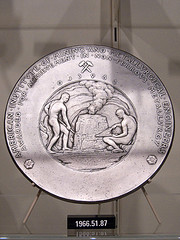Grain Refining in Stainless Steels
 Austenitic stainless steels, despite their excellent corrosion resistance, have low yield strength. One of the most effective ways to increase yield strength without impairing good ductility is by grain refinement. Austenitic stainless steels do not exhibit any transformation during hot deformation, so grain refinement can be achieved only by recrystallization. Using these processes, grain refinement is limited to about 10 microns [1,2]. Therefore, austenitic stainless steels are commonly subjected to cold deformation in order to increase their strength. However, austenitic stainless steels become magnetic after the sufficient cold deformation due to the formation of strain–induced martensite. These steels are renowned for their non–magnetic properties which is the first tangible characteristics when these steels are compared with ferritic and martensitic stainless steels. Therefore, these steels cannot further be used as non–magnetic materials [3].
Austenitic stainless steels, despite their excellent corrosion resistance, have low yield strength. One of the most effective ways to increase yield strength without impairing good ductility is by grain refinement. Austenitic stainless steels do not exhibit any transformation during hot deformation, so grain refinement can be achieved only by recrystallization. Using these processes, grain refinement is limited to about 10 microns [1,2]. Therefore, austenitic stainless steels are commonly subjected to cold deformation in order to increase their strength. However, austenitic stainless steels become magnetic after the sufficient cold deformation due to the formation of strain–induced martensite. These steels are renowned for their non–magnetic properties which is the first tangible characteristics when these steels are compared with ferritic and martensitic stainless steels. Therefore, these steels cannot further be used as non–magnetic materials [3].
A heuristic grain refining method which is called Strain–Induced Martensitic Transformation and its Reversion to austenite (SIMTR) has been invented. In this process, the metastable austenite could be almost completely transformed to martensite during cold deformation and successive reversion of martensite to austenite enables a marked grain refinement. Therefore, processing parameters should be carefully controlled in order to obtain higher than 90% martensite from cold deformation [1]. On the other hand, annealing conditions should be carefully controlled in order to obtain a fine grained fully austenitic structure [2].
In the first paper, the effect of cold working temperature, the amount of deformation, the strain rate and the initial austenite grain size on the volume fraction of strain–induced martensite in the AISI 301 stainless steel alloy was modeled by means of Artificial Neural Networks (ANNs) [1]. In the second paper, the effect of annealing temperature and time on the reversion of strain–induced martensite to austenite in the cold worked AISI 304 stainless steel alloy was modeled by means of ANNs [2]. In the third paper, the effect of strain and deformation temperature on the volume fraction of strain–induced martensite in the cold worked AISI 304 stainless steel was modeled by means of ANN. Moreover, the appropriate grain refining zone and safe deformation zone (for preserving non–magnetic properties in cold working) were determined from this model [3].
ANN is a powerful tool for modeling, especially when the underlying data relationships between the inputs and outputs are unknown. ANN modeling can overcome some of the difficulties associated with ordinary methods. For example, it does not need to choose a (physical) relationship between the parameters before analysis [1–3].
More Info
[1] H. Mirzadeh and A. Najafizadeh, Correlation between processing parameters and strain–induced martensitic transformation in cold worked AISI 301 stainless steel, Materials Characterization 59 (2008) 1650–1654.
[2] H. Mirzadeh and A. Najafizadeh, Modeling the reversion of martensite in the cold worked AISI 304 stainless steel by artificial neural networks, Materials & Design 30 (2009) 570–573.
[3] H. Mirzadeh and A. Najafizadeh, ANN modeling of strain–induced martensite and its applications in metastable austenitic stainless steels, Journal of Alloys and Compounds 476 (2009) 352–355.





Рейтинг популярности - на эти заметки чаще ссылаются:
- 43 Герой социалистического труда
- 42 Известный телеведущий целую неделю снимал о Южном Урале
- 41 Первый чугун на каменном угле
- 39 Механизация очистки горновых канав
- 38 Замена конвейерных лент
- 36 Отработка верхнего шлака
- 34 Безотходное производство чугуна
- 33 Металлургия России: всем выйти из кризиса Читать полностью:
- 33 Ремонты чугунных и шлаковых канав
- 33 Системы программного управления